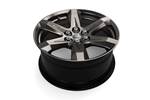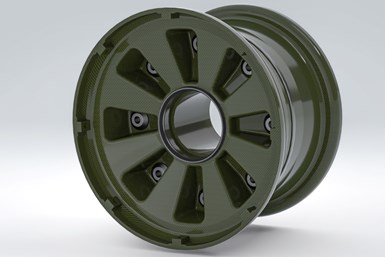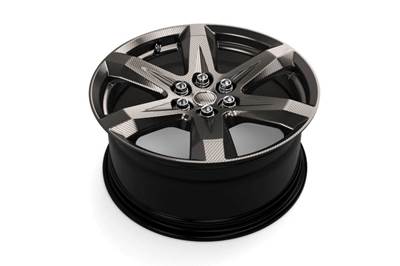Carbon Revolution composite concept wheel for CH-47 Chinook expands benefits to aerospace
The Tier 1 automotive supplier concept wheel is 35% lighter than legacy aerospace versions and withstands durability needs, provides entry point into other vertical lift aerospace and military applications.
The virtually validated wheels are designed to withstand the CH-47’s maximum takeoff weight of 24,500 kilograms. Photo Credit, all images: Carbon Revolution
Carbon fiber automotive wheel supplier Carbon Revolution (Geelong, Australia) has demonstrated the strength and capabilities of its lightweight wheels in aerospace applications, having successfully delivered a virtually validated composite wheel for the Boeing (Chicago, Ill., U.S.) CH-47 Chinook helicopter.
The project, funded by an Australian Government Defence Innovation Hub contract, saw Carbon Revolution engineers design a prototype wheel which is 35% lighter than current wheels used on the Chinook, while still standing up to all of the rigors a military application demands in durability and accommodation of legacy hardware.
Carbon Revolution CEO, Jake Dingle says the program represented a significant opportunity for the company to demonstrate the benefits of its lightweight technology in aerospace applications, while emphasizing the strength of carbon fiber wheels.
“Our design and engineering team focused heavily on optimizing the global architecture to find the most efficient structure to support the loading within the design space envelope,” Dingle says. “Our concept wheel shows a 35% reduction in weight (60 pounds over six wheels) is achievable with potential to achieve a greater reduction, thanks to our lightweight carbon fiber technology, and our team’s work to optimize the wheel’s geometry to improve its efficiency.”
Dingle adds that the program represented a great opportunity for Carbon Revolution, a Tier 1 automotive supplier, to extend the application of its technology to the aerospace sector, which goes to significant lengths to save weight in aircraft design.
“These wheels could be supplied on new build CH-47 Chinook helicopters, and retrofitted to thousands of current CH-47s operating worldwide, but a real opportunity for us lies in other civilian and military vertical lift aircraft applications,” Dingle explains. “In particular, the weight savings for commercial operators would result in substantial savings in fuel costs.”
Carbon Revolution Chief Technology Officer (CTO), Dr. Ashley Denmead says the project demonstrated his team’s capabilities beyond automotive wheels. The wheels are designed to meet the CH-47’s maximum static vertical load requirement of more than 9,000 kilograms per wheel. By comparison, the requirement for one of Carbon Revolution’s ultra-lightweight wheels for a high-performance car is around 500 kilograms per wheel.
“This aerospace project brought a number of different design requirements which in many cases are far more rigorous than automotive,” Dr. Denmead points out. “The fact that we can meet these requirements and still make a wheel that’s much lighter is a testament to the strength of carbon fiber, and the talent of our team to design an extremely robust wheel.”
The virtual validation report delivered to the Defence Innovation Hub included results from finite element analysis (FEA), subscale testing and internal ply architecture design.
“We have also been considerate of other important aspects during the design process, such as in-service inspections and the manufacturability of the wheels,” Dr. Denmead continues. “These are crucial in ensuring the real-world viability of a program like this for us and our customers.”
The next phase of the program will involve Carbon Revolution producing and testing prototype wheels, with the possibility of expanding to other aerospace applications in the future.
Related Content
Welding is not bonding
Discussion of the issues in our understanding of thermoplastic composite welded structures and certification of the latest materials and welding technologies for future airframes.
Read MorePlant tour: Teijin Carbon America Inc., Greenwood, S.C., U.S.
In 2018, Teijin broke ground on a facility that is reportedly the largest capacity carbon fiber line currently in existence. The line has been fully functional for nearly two years and has plenty of room for expansion.
Read MorePlant tour: Joby Aviation, Marina, Calif., U.S.
As the advanced air mobility market begins to take shape, market leader Joby Aviation works to industrialize composites manufacturing for its first-generation, composites-intensive, all-electric air taxi.
Read MoreMcLaren celebrates 10 years of the McLaren P1 hybrid hypercar
Lightweight carbon fiber construction, Formula 1-inspired aerodynamics and high-performance hybrid powertrain technologies hallmark this hybrid vehicle, serve as a springboard for new race cars.
Read MoreRead Next
Carbon Revolution meets automotive market demand with lightweight carbon fiber wheels
Twenty-three-inch and 24-inch carbon fiber wheel offerings meet growing EV SUV and truck load requirements with 45% weight savings comparable to aluminum wheels.
Read MoreDeveloping bonded composite repair for ships, offshore units
Bureau Veritas and industry partners issue guidelines and pave the way for certification via StrengthBond Offshore project.
Read MoreVIDEO: High-volume processing for fiberglass components
Cannon Ergos, a company specializing in high-ton presses and equipment for composites fabrication and plastics processing, displayed automotive and industrial components at CAMX 2024.
Read More



















.jpg;maxWidth=300;quality=90)








